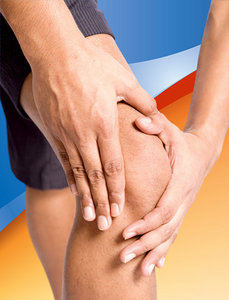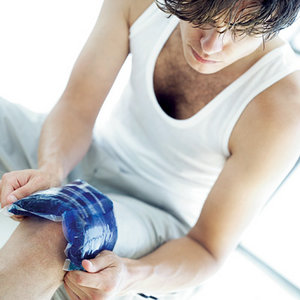Here's a question I get asked all the time... "Ice or Heat?"
You're at the park on a glorious Saturday morning playing a friendly game of basketball with your fellow weekend warriors. You jump for a rebound and land awkwardly, twisting your knee, and drop to the ground in pain. Moments later, you've been helped off the court by teammates and are watching your knee slowly but surely start to swell.
What should you do next? Too many people essentially shrug off the pain and return to the game after a few minutes of "rest," hoping everything will return to normal. That attitude can turn a simple strain or sprain into a chronic injury that limits your activities for weeks or even months.
When joint and muscle injuries occur, immediate application and continuation of first aid is vital. Delayed or incorrect first aid will slow the healing process dramatically. What do you do when you or someone you know suffers this type of injury? Here are a few things you can do immediately to start the healing process.
The R.I.C.E. Recovery Formula
 Remembering the acronym R.I.C.E. is of great help whenever joint or muscle first aid is needed. The acronym stands for Rest, Ice, Compression and Elevation. Immediately following an injury involving the muscles or joints, these four steps should be taken:
Remembering the acronym R.I.C.E. is of great help whenever joint or muscle first aid is needed. The acronym stands for Rest, Ice, Compression and Elevation. Immediately following an injury involving the muscles or joints, these four steps should be taken:Resting an injured area reduces the stress and strain which, in turn, reduces the chance of further injury. When an injury occurs, immediately stop using the injured area.
Ice applied to an injured joint or muscle reduces swelling and bleeding by slowing blood flow to the area.
Compression (wrapping or taping the area of injury) reduces swelling and gives extra support to injured tissues. Compression applies primarily to the extremities (arms and legs).
Elevation of the injured body part above the level of the heart slows blood flow to the area by forcing the heart to pump "uphill." Reducing blood flow reduces swelling. Elevation applies primarily to injuries involving the extremities (arms, legs, feet and hands).
Heat or Cold: Which to Use?
Actually, heat and cold are both important components of recovery following an injury, but it's important to understand which to use and how to achieve maximum benefit. Remember these general rules when considering whether to apply ice or heat:
Applying Ice Properly
 WHEN: Ice or gel packs are the first choice of care during the first 48-72 hours following injury.
WHEN: Ice or gel packs are the first choice of care during the first 48-72 hours following injury. HOW: The application of ice directly to an injured or painful area of the body can be quite a shock at first. To avoid this, apply the ice pack as follows: Apply the ice, or gel pack over a towel which will allow for a gradual cooling and more comfort. Place the towel under hot (but not scalding) running water, wring out the excess water and place the towel on the affected area.
FREQUENCY: Each application of ice/gel packs should be 20-30 minutes, with 3-5 applications per day.
WARNINGS: Never apply ice for longer than 30 minutes at a time, and not at all if the injured party is suffering from any of the following: frostbite, areas of decreased sensation, Raynaud's disease, severe circulation problems, rheumatoid or gouty arthritis, or a worst-case scenario such as coma. Also do not use chemical ice bags that require shaking or have to be struck to be activated. Shaking and striking these bags may result in leakage of the active chemicals. The chemicals are usually caustic and may result in burns or other injuries.
Applying Heat Properly
 WHEN: Moist heat may be applied 48-72 hours after injury. Heat increases
circulation by dilating blood vessels and letting more blood into the
area.
WHEN: Moist heat may be applied 48-72 hours after injury. Heat increases
circulation by dilating blood vessels and letting more blood into the
area.HOW: Moist heat provides more soothing relief than dry heat. Gel packs, hot towels, hot baths, hot showers, whirlpools, steam saunas, and moist heating pads are examples of heat with moisture.
FREQUENCY: Each application of moist heat should be 20-30 minutes, with 3-5 applications per day.
WARNINGS: Never apply moist heat for longer than 30 minutes. Never sleep on a heating pad.
 Gel Packs: Two Treatments in One
Gel Packs: Two Treatments in OneThe most versatile piece of home therapy equipment you can own is a gel pack ( I have them for sale in the office if you can't find them on your own). Gel packs can be utilized for both cold and hot applications. Most are stored in the freezer until the need arises for cold application. If heat is needed, the pack can be transferred from the freezer to the microwave and heated as directed. Gel packs come in a variety of sizes and stay flexible at all temperatures. Constant flexibility allows the pack to be molded to the area of injury. Remember, it is always a good idea to place a towel between your skin and the gel pack.
Cut these instructions out and tape them on the inside of a medicine or kitchen cabinet so they will always be readily available whenever you or someone you know suffers a joint or muscle injury requiring first aid. Remember, the type, severity and circumstances surrounding the injury can impact the precise course of treatment to be pursued. For example, joint or bone deformity, uncontrollable bleeding associated with injury, loss of consciousness, loss of feeling in the area of injury, convulsions, etc., require immediate medical attention. Always consult with your doctor if you are unsure of the severity of an injury or if you have further questions regarding appropriate first-aid treatment.
Dr Gene, this is great information. I've gotten this question many times over the years. I'll share the info. Thank you.
ReplyDeleteYou got a really useful blog I have been here reading for about an hour. I am a newbie and your success is very much an inspiration for me.
ReplyDeleteNorwich Orthopedic Group ct & Occupational Therapy Rehabilitation ct